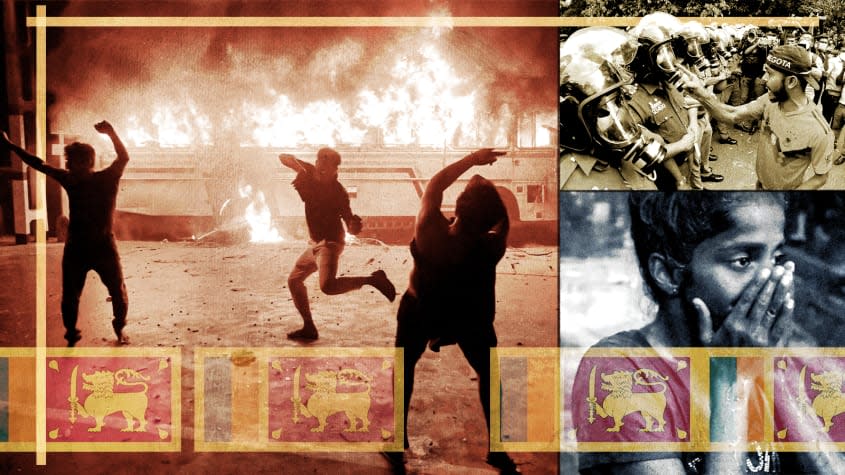Why are protests still raging in Sri Lanka?

- Oops!Something went wrong.Please try again later.
Since the spring, anti-government protesters in Sri Lanka have been hitting the streets, demonstrating against high inflation, fuel and medicine shortages, rolling blackouts, and more. On Saturday, the situation escalated when thousands of protesters stormed the official residences of Sri Lanka's president, Gotabaya Rajapaksa, and prime minister, Ranil Wickremesinghe. Here's everything you need to know:
Why are Sri Lankans protesting?
The South Asian country, home to 22 million people, is experiencing its worst economic downturn since gaining independence in 1948, and everyone is feeling the squeeze. On the economic side, the agricultural sector was hit hard in recent years, after the government banned chemical fertilizers and heavy monsoons ruined crops. The government borrowed a lot of money from foreign lenders in order to fund public services, and when the economy slumped because of COVID-19 and a drop in tourism, taxes were cut. The government then lost so much revenue that it had to start paying off its debt with foreign exchange reserves. By this spring, the government did not have enough money to pay for fuel imports, resulting in shortages, and inflation soared. In May, Sri Lanka defaulted on its debt for the first time ever.
Protesters began demonstrating in March, and not just because of the economy; they are also taking issue with Sri Lanka's leadership, believing that the Rajapaksa family has been in charge for too long. Before Gotabaya became president in 2019, his brother Mahinda was president from 2005 to 2015, and various other relatives are also high up in the government.
What do the protesters want?
They have been calling on the president and prime minister to both resign, blaming Rajapaksa especially for the economic collapse. "People from all walks of life have united with one intention: to demand that the corrupt president who clearly does not have a mandate step down," protester Himantha Wickremerathne told The Washington Post. On Saturday, thousands of protesters in the capital Colombo stormed the official residences of the president and prime minister, and later, some demonstrators set fire to Wickremesinghe's private home. The men were not at their residences, and went into hiding. On Wednesday, three immigration officials told The New York Times that Rajapaksa fled the country overnight, leaving on an Air Force plane.
What did the protesters do inside the residences?
News footage showed people jumping into the pool at the presidential residence, and Al Jazeera reports that some went into the kitchen to make themselves tea. Other recordings show people taking selfies or posing for photographs, with many waving Sri Lanka's flag.
Before protesters breached the residences, they gathered in Colombo's administrative district, where clashes broke out between demonstrators and security forces. After breathing in tear gas, dozens of protesters went to Colombo's main hospital for medical treatment, Al Jazeera reports, with three others going in after sustaining gunshot wounds.
How did Rajapaksa and Wickremesinghe respond?
Government officials report that both Rajapaksa and Wickremesinghe have said they will step down, and Rajapaksa's office confirmed that his cabinet will also resign as soon as a deal is reached to form an all-party government. Protest leaders have said they won't leave the residences of the president and prime minister until Rajapaksa and Wickremesinghe are officially out of office. "We are not going anywhere til this president leaves and we have a government that is acceptable to the people," demonstrator Jude Hansana, who has been protesting near the presidential residence since April, told Reuters.
Who will take over for Rajapaksa?
Usually, the prime minister would become acting president, but since Wickremesinghe also intends to resign, things are slightly up in the air. Most likely, Mahinda Yapa, the speaker of Parliament and an ally of the Rajapaksa family, will step into the role of interim president, the Times says. In a statement on Monday, Yapa said Parliament will reconvene on July 15 and vote to elect a new president on July 20.
You may also like
Could this SCOTUS case push America toward one-party rule?
The James Webb Space Telescope's 1st full-color image has been revealed

